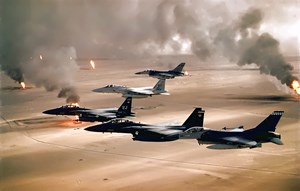Persian Gulf War

In a move that provoked international condemnation and sent crude on an upward trajectory, Saddam Hussein’s Iraq invaded neighboring Kuwait on Aug. 2, 1990.
The invasion prompted an embargo on crude and refined products from both countries, and, according to data from the U.S. Energy Information Administration, Brent spiked from $18.91/bbl in the last week of July to $40.79/bbl in the last week of September.
The occupation, and the perceived threat to Saudi Arabia—and its oil—prompted a U.S.-led effort to rush troops to the Kingdom, in an effort to deter further Iraqi aggression, an effort known as Operation Desert Shield.
Toward the end of November, the United Nations authorized the use of force, if Iraq refused to withdraw its occupying troops by Jan. 15, 1991. However, despite the threat, Saddam refused to back down. On Jan. 16–17, the U.S.-led coalition began air strikes—code named Operation Desert Storm—as part of its military campaign to liberate Kuwait. The allies launched a ground offensive—code named Operation Desert Sabre—against Iraq on Feb. 24, with President George H. W. Bush declaring a cease-fire on Feb. 28, after Iraqi resistance crumbled.
The war, itself, may have been relatively short-lived, but the road ahead would be hard and present challenges. While withdrawing from Kuwait, the Iraqi military sabotaged hundreds of oil wells, which would take months to cap, Fig. 1. ![]()


